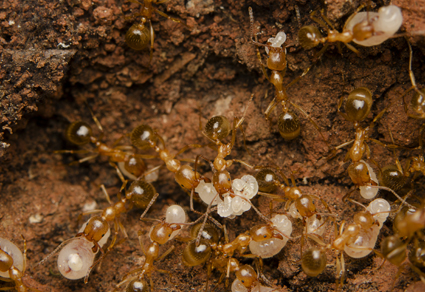Abstract
The Canary Islands endemic species Aphaenogaster hesperia Santschi, 1911 was described based solely on two workers captured in a north-western coastal area of Tenerife (Canary Islands) in 1902 and 1903. The species has not been recorded in the last 100 years and only information on its type locality is known. This species, belonging to the crocea group, has been recently rediscovered in a new site within a pine forest at 950 m a.s.l. The new area is a very different habitat, revealing a lack of ecological knowledge of the species, which may have caused the species to have remained unnoticed for more than 100 years. Novel distributional and morphological data are provided.
References
- Alicata, A. & Schifani, E. (2019) Three endemic Aphaenogaster from the Siculo-Maltese archipelago and the Italian Peninsula: part of a hitherto unrecognized species group from the Maghreb? (Hymenoptera: Formicidae: Myrmicinae). Acta Entomologica Musei Nationalis Pragae, 59, 1–16. https://doi.org/10.2478/aemnp-2019-0001
- del Arco-Aguilar, M. & Rodríguez Delgado, O. (2018) 16 Vegetation of the Canary Islands. Springer, Utrecht, 437 pp. Available from: http://www.springer.com/series/7549 (Accessed 6 Dec. 2023) https://doi.org/10.1007/978-3-319-77255-4_1
- Bolton, B. (2023) An online catalog of the ants of the world. Available from: https://antcat.org/catalog/429816 (Accessed 14 July 2023)
- Branstetter, M.G., Longino, J.T., Reyes-López, J.L., Brady, S.G. & Schultz, T.R. (2022) Out of the temperate zone: A phylogenomic test of the biogeographical conservatism hypothesis in a contrarian clade of ants. Journal of Biogeography 49, 1640–1653. https://doi.org/10.1111/jbi.14462
- Cagniant, H. (1997) Le genre Tetramorium au Maroc (Hymenoptera: Formicidae): clé et catalogue des espèces. Annales de la Société Entomologique de France, 33, 89–100. https://doi.org/10.1080/21686351.1997.12279181
- Carroll, J.F. (1975) Biology and ecology of ants of the genus Aphaenogaster in Florida. University of Florida. https://doi.org/10.5962/bhl.title.42329
- Caut, S., Barroso, Á., Cerdá, X., Amor, F. & Boulay, R.R. (2013) A year in an ant’s life: Opportunism and seasonal variation in the foraging ecology of Aphaenogaster senilis. Ecoscience, 20, 19–27. https://doi.org/10.2980/20-1-3559
- Emery, C. (1882) Le crociere dell’yacht “Corsaro” del capitano armatore Enrico d’Albertis. II. Formiche. Annali del Museo Civico di Storia Naturale 18, 448–452.
- Espadaler, X. (2007) The ants of El Hierro (Canary Islands). In: Snelling, R.R., Fisher, B.L. & Ward, P.S. (Eds.), Advances in ant systematics (Hymenoptera: Formicidae): homage to E. O. Wilson – 50 years of contributions. Memoirs of the American Entomological Institute, 80, 113–127.
- Forel, A. (1893) Quelques fourmis des Canaries, récoltées par M. Cabrera y Diaz. Annales de la Société Entomologique de Belgique, 37, 464–466.
- Galkowski, C., Aubert, C. & Blatrix, R. (2019) Aphaenogaster ichnusa santschi, 1925, bona species, and redescription of Aphaenogaster subterranea (Latreille, 1798) (Hymenoptera, Formicidae). Sociobiology, 66, 420–425. https://doi.org/10.13102/sociobiology.v66i3.3660
- Gobierno de Canarias (2023) Banco de Datos de Biodiversidad de Canarias. Available from: http//:www.biodiversidadcanarias.es/biota/ (Accessed 4 May 2023)
- Hernández-Teixidor, D., Pérez-Delgado, A.J., Suárez, D. & Reyes-López, J. (2020) Six new non-native ants (Formicidae) in the Canary Islands and their possible impacts. Journal of Applied Entomology, 144, 434–441. https://doi.org/10.1111/jen.12751
- Janicki, J., Narula, N., Ziegler, M., Guénard, B. & Economo, E.P. (2016) Visualizing and interacting with large-volume biodiversity data using client-server web-mapping applications: The design and implementation of antmaps.org. Ecological Informatics, 32, 185–193. https://doi.org/10.1016/j.ecoinf.2016.02.006
- Johnson, R.A. & Rutowski, R.L. (2022) Color, activity period, and eye structure in four lineages of ants: Pale, nocturnal species have evolved larger eyes and larger facets than their dark, diurnal congeners. PLOS ONE, 17 (9), e0257779. https://doi.org/10.1371/journal.pone.0257779
- Lubertazzi, D. (2012) The biology and natural history of Aphaenogaster rudis. Psyche: A Journal of Entomology, 2012, 1–11. https://doi.org/10.1155/2012/752815
- Santschi, F. (1908) Nouvelles fourmis de l’Afrique du nord (Égypte, Canaries, Tu). Annales de la Societe Entomologique de France, 77, 517–534.
- Santschi, F. (1911) Formicides de diverses provenances. Annales de la Société Entomologique de Belgique, 55, 278–287.
- Santschi, F. (1919) Fourmis d’Espagne et des Canaries. Boletín de la Real Sociedad Española de Historia Natural, Sección Biología, 19, 241–248.
- Santschi, F. (1937). Contribution à l’étude des Crematogaster paléarctiques. Mémoires de la Société Vaudoise des Sciences Naturelles, 5, 295-317.
- Schembri, S.P. & Collingwood, C.A. (1981) A revision of the myrmecofauna of the Maltese Islands (Hymenoptera, Formicidae). Annali del Museo Civico di Storia Naturale Giacomo Doria (Genova), 83, 417–442.
- Schifani, E., Alicata, A., Borowiec, L., García, F., Gentile, V., Gómez, K., Nalini, E., Rigato, F., Schär, S., Scupola, A., Vila, R. & Menchetti, M. (2023) Unrecognized for centuries: distribution and sexual caste descriptions of the West European Aphaenogaster species of the subterranea group (Hymenoptera, Formicidae). ZooKeys, 1153, 141. https://doi.org/10.3897/zookeys.1153.98297
- Schifani, E., Alicata, A., Menchetti, M., Borowiec, L., Fisher, B.L., Karaman, C., Kiran, K., Oueslati, W., Salata, S. & Blatrix, R. (2022) Revisiting the morphological species groups of West-Palearctic Aphaenogaster ants (Hymenoptera: Formicidae) under a phylogenetic perspective: toward an evolutionary classification. Arthropod Systematics and Phylogeny, 80, 627–648. https://doi.org/10.3897/ASP.80.E84428
- Schifani, E., Costa, S., Mei, M. & Alicata, A. (2021) A new species for the Italian fauna: Aphaenogaster strioloides, not A. crocea, inhabits Pantelleria Island (Hymenoptera: Formicidae). Fragmenta entomologica, 53 (1), 21–24. https://doi.org/10.13133/2284-4880/482
- Seifert, B. (2020) Revision of the Plagiolepis schmitzii group with description of Pl. invadens sp. nov.–a new invasive supercolonial species (Hymenoptera: Formicidae). Deutsche Entomologische Zeitschrift, 67 (2), 183–196. https://doi.org/ 10.3897/dez.67.53199
- Snelling, R.R. & George, C.D. (1979) The taxonomy, distribution and ecology of California desert ants (Hymenoptera: Formicidae). Report to Bureau of Land Management, US Department of Interior, Riverside, California, 335 pp. https://doi.org/10.5962/bhl.title.119643
- Villalta, I., Oms, C.S., Angulo, E., Molinas-González, C.R., Devers, S., Cerdá, X. & Boulay, R. (2020) Does social thermal regulation constrain individual thermal tolerance in an ant species? Journal of Animal Ecology, 89, 2063–2076. https://doi.org/10.1111/1365-2656.13268
- Ward, P.S., Brady, S.G., Fisher, B.L. & Schultz, T.R. (2015) The evolution of myrmicine ants: Phylogeny and biogeography of a hyperdiverse ant clade (Hymenoptera: Formicidae). Systematic Entomology, 40, 61–81. https://doi.org/10.1111/syen.12090


